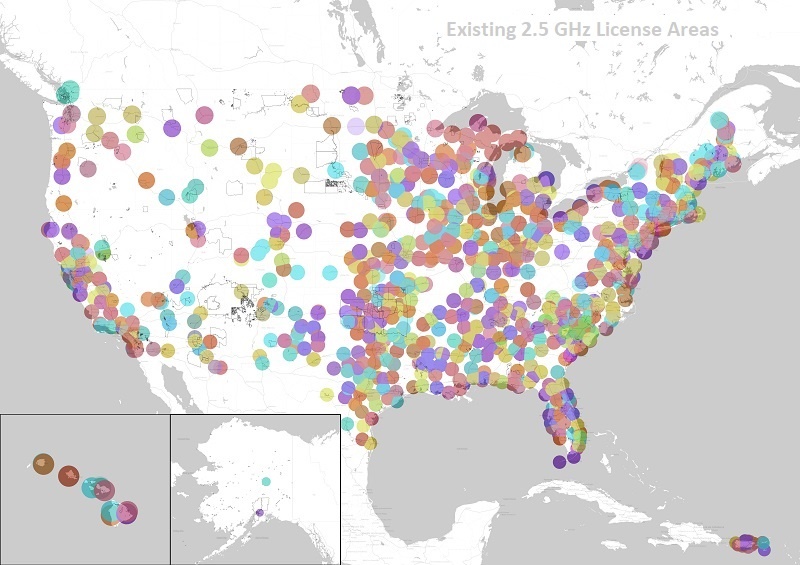We are excited to see this unique opportunity for our big brother and sister tribes in United States. On July 10, 2019, the FCC passed an order that enables federally-recognized Tribal Nations to claim unlicensed EBS spectrum over their lands before competitive bidding begins. While this is a great opportunity, there is only 90 days of education and outreach followed by a 60-day application window. We can help you through the process so you can bring broadband to your community.
The 60-day tribal priority window opens February 2020 if the FCC is granted an accelerated review by the Office of Management and Budget (OMB). Otherwise the window starts May 2020. Immediately following the tribal priority window, remaining spectrum will be auctioned off by county.
Want a later tribal priority window? By October 3rd, email the OMB and the FCC with the subject line: Transforming the 2.5 GHz band at Cathy.Williams@fcc.gov, PRA@fcc.gov and Nicholas_A._Fraser@omb.eop.gov.
Please reach out to us if you have any question regarding this process. We are encouraging each tribes to submit formal applications to acquire this spectrum. We would be happy to assist you in the application process or at minimum submitting a letter of intent.
Considerations
- EBS spectrum is in the 2.5 GHz band which is ideal for rural deployments.
- There is up to 116.5 MHz of spectrum that could be available over all or part of tribal lands.
- Spectrum is an appreciating asset and EnerTribe recommends that the tribal councils & enterprises claim as much spectrum as possible.
- FCC buildout requirements are aggressive but attainable.
- Fixed-wireless networks are relatively cheap to build.
- Competing claims to the same geographical service area (GSA) have to go to auction so interested parties should coordinate licensing. This could mean limiting the GSA, choosing different channels, etc.
- Licensed spectrum can be leased to third parties
FAQ about the FCC Order
Who is eligible?
Federally recognized American Indian Tribes and Alaska Native Villages on rural Tribal lands, their extended communications providers, and other entities that provide communications and other services, if they are owned and controlled by federally recognized Tribes or a consortium of such Tribes, including some Tribal Colleges and Universities are eligible. Multiple applications for the same Tribal lands will be resolved through competitive bidding.
What are rural Tribal lands?
The FCC adopted the broad definition of Tribal lands set forth in Part 54 of the Commission’s rules. The FCC further designated off-reservation Tribal lands as eligible for the Tribal priority window if they have already been designated (as of the adoption date of this Report and Order) as Tribal lands pursuant to the designation process contained in section 54.412 of the universal service rules. Tribal lands will be considered rural and eligible if they are not part of an urbanized area or urban cluster area with a population equal to or greater than 50,000. Applicants must have a local presence on the Tribal lands.
What are the requirements?
The educational requirement for use of this spectrum is removed and licensed spectrum can be leased to third parties. For mobile, point-to-multipoint or broadcast service, the requirements are 50% population coverage within two years and 80% within five years. For point-to-point, the requirements are 20 links per million persons (one link per 50,000) within two years and 40 links per million (one link per 25,000) within five years.
Issues with the Order
- The outreach window of 90-days and application window of 60-days is too short for tribal councils new to EBS spectrum to learn about this opportunity, prepare engineering studies and apply for spectrum.
- Tribal nations are expected to meet buildout requirements nearly twice as major telecoms who win spectrum at auction. This is inherently unfair.
- In consultation with tribal partners, we will be urging the FCC to adopt a year-long tribal priority window with a rolling application approval process. In addition to providing more time for tribal leadership to plan for obtaining spectrum, a longer window will allow for tribal nations without adequate broadband service to observe the impact and efficacy of networks established and owned by other tribal communities. This will lead to more licenses granted to rural tribal nations, more networks being built and more under-connected people having access to all that broadband has to offer.
- Also, spectrum auction winners should have the same buildout requirements and timelines as tribal nations who claim the spectrum during a tribal priority window. Infrastructure can be deployed fast and some tribal communities will have networks running within weeks of being granted a license. However, a lot of tribal nations new to wireless Internet networks and 2.5 GHz spectrum policies do not have that capacity just yet. It seems illogical that they are expected to deploy networks faster than multi-billion-dollar companies whose sole purpose is growing and maintaining telecommunications networks.
